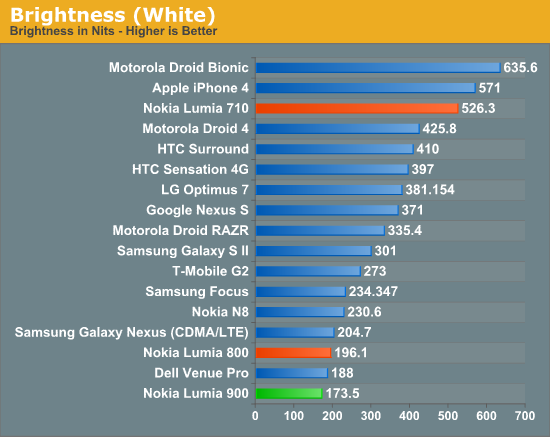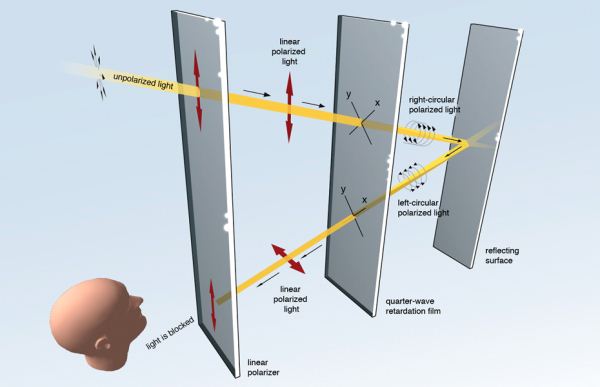Nokia Lumia 900 Review - Windows Phone with LTE
by Brian Klug on April 3, 2012 9:00 PM ESTDisplay Quality
Like the Lumia 800, the Lumia 900 uses an AMOLED display instead of an LCD. One of the chief differentiators between the two models however is the difference in subpixel rendering. Whereas the Lumia 800 used a 3.7“ PenTile RGBG SAMOLED panel, the Lumia 900 uses a 4.3” SAMOLED+ panel with an RGB subpixel stripe. Those names fit, that is, if we’re following Samsung’s naming scheme, and as an aside this is undoubtedly a Samsung panel.
The effective resolution of both displays are 800x480 WVGA, like all Windows Phones, however. Jumping up in display size pretty much necessitates that change to RGB, since PenTile really only works when subpixels are below human visual acuity. In addition, we’ve already seen 4.3" SAMOLED+ WVGA displays out of Samsung (see the Focus S).
I measured the Lumia 900 display using an i1D2 just like I’ve done with numerous other smartphones, though at this point the advanced color and gamut information will have to wait until I make some targets. Again, because AMOLED is emissive, black color pixels are literally off, so contrast graphs are omitted. The Lumia 900 doesn’t go super bright, like other AMOLEDs I’ve seen. In fact, it’s slightly dimmer than the Lumia 800’s maximum of 196 nits. Remember that going to a larger display, especially AMOLED due to its emissive nature, increases power demands as r^2 since we’re talking about areal size.
| Lumia 900 Display Metrics | |||
| Brightness Level | Black Brightness (nits) | White Brightness (nits) | White Point (K) |
| Low | 0 | 72.68 | 6635 |
| Medium | 0 | 140.06 | 6930 |
| High | 0 | 173.55 | 6812 |
Nokia was able to get the Lumia 900 display nice and close to 6500K, which is interesting considering how many other AMOLED displays I’ve seen which are up near 8000K or higher and noticeably blue all the time.

I glossed over ClearBlack on the previous Lumia reviews partly due to time constraints, partly due to not knowing the exact details of their optical path. That said, it was immediately obvious that the system used circular polarization’s behavior upon reflection to attenuate back reflections. However, since writing those reviews, Nokia has outlined their optical system in a conversations post, and the long and short of it is that the system consists of a linear polarizer and quarter-wave plate.
Incoming diffuse light gets vertically polarized by a surface polarizer, which becomes right hand circularly polarized when passing through the quarter wave plate. When circular polarized reflects off of a surface, it changes handedness - in this case from right to left handed circular. Upon passing through the quarter wave plate on its way out, this becomes horizontally polarized, which is then strongly attenuated by the surface polarizer with its fast axis aligned vertically on its way out, which acts like an analyzer. The end result is that outdoors the only reflection you’ll get is from the first surface, not the surface of the display itself, which does reduce resulting glare.
This change also permits the Lumia 900 to still look bright outside, and in turn allows Nokia to run the display at a lower brightness and save some amount of power. For a while I was waiting for some OEM to introduce a system using polarization to diminish back reflections, and Nokia has done it with ClearBlack.
Indoor viewing angles for the Lumia 900 are excellent as evidenced by the purple test pattern from WP Bench not changing color at extreme field angles. In addition, I subjectively can’t find any issues with the display - there are none of the other problems that affect the higher dot pitch AMOLEDs such as grain or mura. Outdoor viewing angles are likewise good for the Lumia 900 in part thanks to ClearBlack.

















128 Comments
View All Comments
lunarx3dfx - Wednesday, April 4, 2012 - link
I agree with edd. I recently bought a focus flash after using a Nexus S for almost a year, and even with ics the Nexus wasn't anywhere near as smooth as WP7 is. Sure, gpu acceleration helped, but there are other underlying problems in Android.That being said however, I will probably be getting the HTC ONE X or the US GSM Galaxy Nexus (if it ever launches) because the one area WP really lacks is in providing features for power users. It is a beautiful os, and as a whole I really enjoy it, but I miss being able to customize everything like I could on android.
papatom - Wednesday, April 4, 2012 - link
Besides there is a lot more that the underlying OS has to offer.Let's see how WP subjective performance changes (tanks?) when Microsoft adds all those features.
They will bring the platform in-line feature wise, won't they?
Another thing, as pointed by Exodite, is that the first crop of WP phones - at least reference ones - comes from Nokia, and is polished to the point OS permits.
sprockkets - Wednesday, April 4, 2012 - link
I'm at 1.2ghz and 768 memory with only around 400 available for me to use! Sure it's dual core, but again, the GPU does its job now.Here, read this from an actual developer of Android.
https://plus.google.com/105051985738280261832/post...
mutatio - Wednesday, April 4, 2012 - link
Careful, Vision, that comes awful close to complimenting Apple's approach since day one of the iPhone. ;-)Exodite - Wednesday, April 4, 2012 - link
Ah yes, the wonders of anecdotal evidence and conjecture.Incidentially I have an Android phone based on very similar hardware, an 1GHz Qualcomm S2 SoC, 512MB memory and a FWVGA display.
And it runs absolutely beautifully.
It's the SE arc though, kinda funny how the old guard in phones still seem to come up with some of the best solutions.
designerfx - Friday, April 6, 2012 - link
wow, really?do you understand the point of quad core? it's not performance, it's more power savings.
WP is not more efficient than anyone - if you think it is the OS, you don't understand that probably 99% of the performance (positive or negative) is based on the chips in the phone and that's it.
crispbp04 - Tuesday, April 10, 2012 - link
You are clueless so please don't speak on subjects you have no idea about. Do you even know what a scheduling is? Maybe when you get an education some day after you graduate high school you'll understand how an operating system works.http://en.wikipedia.org/wiki/Scheduling_(computing...
Saying performance is all hardware is like saying strengh is everything. try holding a 25lb weight 2 feet from you with your arms extended, then hold the same weight to your chest. What is easier?
eddman - Tuesday, April 3, 2012 - link
Why talk time and 3G web browsing battery times are so low, compared to phones with a similar display and a similar or smaller battery?Is this one of the pitfalls of using a dedicated baseband chip?
Brian Klug - Wednesday, April 4, 2012 - link
Basically that, and again that we're talking about (at least for the cellular page loading tests) the same display being the majority of power draw.The tethering results being so close surprised me, and I'm going to re-run the HSPA+ result just to see what was up there. Again very limited time on this review actually.
-Brian
Lonegunman2012 - Wednesday, April 4, 2012 - link
Just a quick question: What is your rush to get the review out? I look to this site for thoroughly written reviews. It's disappointing that so much was left out. I would be happy to wait longer for a review to come out if it was complete.